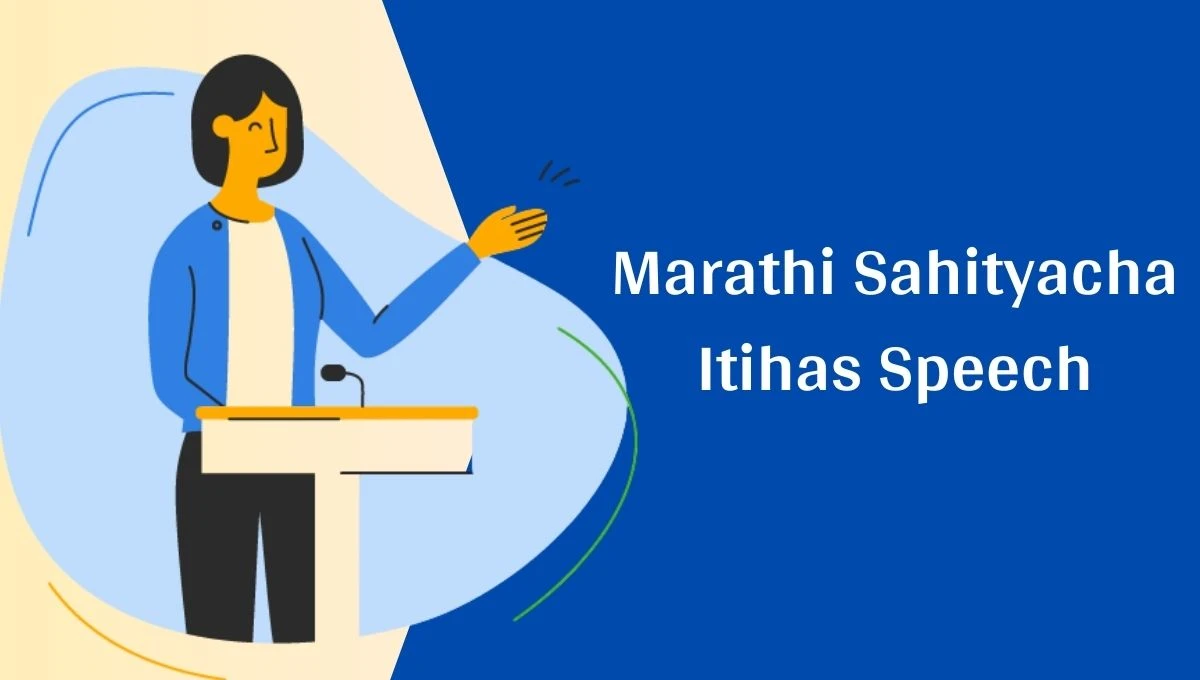Greetings, dear friends and lovers of Marathi literature,
Marathi Sahityacha Itihas Speech: Today, we are embarking on a beautiful and inspiring journey through the history of Marathi literature. Marathi literature is not merely a play of words; it is a reflection of Maharashtra’s culture, history, and the soul of its society. For centuries, this literature has preserved our rich traditions and inspired new generations. Let us begin this journey!
The history of Marathi literature begins around 1000 CE. The earliest glimpse of Marathi literature is found in Saint Dnyaneshwar’s Dnyaneshwari. Written in 1290 CE, Dnyaneshwari is considered the first written work in the Marathi language, based on the Bhagavad Gita. Under the guidance of his guru, Nivruttinath, Saint Dnyaneshwar crafted this work, making the profound teachings of the Gita accessible to the common person in simple language. This text not only elevated Marathi to a literary stature but also laid the foundation for the Bhakti movement. During this period, Dnyaneshwar also wrote Amrutanubhav, a work rooted in Advaita philosophy, which became a cornerstone of Marathi literature.
Following Saint Dnyaneshwar, great saints like Namdev, Eknath, and Tukaram added new dimensions to Marathi literature. Saint Eknath, through works like Bhavarth Ramayana and Eknathi Bhagwat, blended devotion and spirituality. Saint Tukaram’s Abhang poetry is regarded as the pinnacle of Marathi literature. His approximately 4,500 Abhangs gave voice to the emotions, sorrows, and joys of the common person. The simplicity of his language and the depth of his thoughts brought widespread popularity and richness to Marathi literature.
During the medieval period, Marathi literature gave rise to various forms, including poetry, drama, biographies, autobiographies, and folk literature. Folk literature, in particular, preserved the stories, songs, and traditions of rural Maharashtra. This era also saw the emergence of Panditi and Shahiri poetry. Shahiri poetry, which flourished during the time of Chhatrapati Shivaji Maharaj, was imbued with valor and patriotism.
After 1800 CE, Marathi literature embraced modernity. The advent of the printing press during British rule expanded the reach of literature. Thinkers like Vishnu Shastri Chiplunkar, Lokmanya Tilak, and Agarkar transformed Marathi literature into a medium for social reform. Periodicals like Nibandhmala and Kesari gave Marathi literature a new direction. During this time, new literary forms such as novels and plays emerged. Hari Narayan Apte’s novels like Madhali Awastha and Pan Lakshat Kon Gheto addressed social issues.
In the post-independence era, Marathi literature embraced even greater diversity. Writers like P. L. Deshpande, Vasant Sabnis, Jaywant Dalvi, and Vijay Tendulkar enriched Marathi literature through short stories, plays, and novels. Vijay Tendulkar’s play Shantata! Court Chalu Ahe poignantly depicted social realities, while P. L. Deshpande’s humorous writings added a unique charm to Marathi literature.
Pros and Cons of Social Media Speech in English: Pros and Cons of Social Media Speech
In today’s digital age, Marathi literature has retained its significance. The Maharashtra State Literature and Culture Board has published 444 books in e-book format, making Marathi literature accessible to readers worldwide. Additionally, the board has initiated grants and literary festivals to encourage new writers.
This journey of Marathi literature is not just about words; it is about the soul and identity of Maharashtra. From Saint Dnyaneshwar to contemporary digital-age writers, Marathi literature has maintained its creativity and social commitment. It has given us spirituality, devotion, social reform, and entertainment in myriad forms.
Impact of AI on Everyday Life Speech in English: The Impact of AI on Everyday Life
Dear literature lovers, we must cherish this legacy of Marathi literature. Every Marathi individual should read our literature, take pride in it, and pass it on to the next generation. Marathi literature is our identity, our pride, and our inspiration. Let us dive into this ocean of literature and embrace its treasures in our lives!
Thank you!
